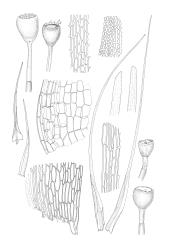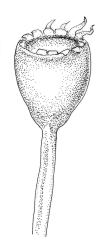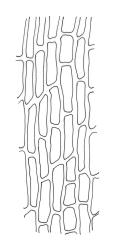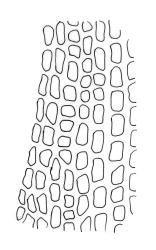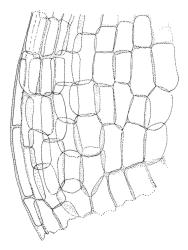- ≡ Weissia contecta Hook.f. & Wilson, London J. Bot. 3: 540 (1844)
Elements in the following description are taken from Bartlett & Vitt (1986).
Plants golden-green to yellow-brown above, olive-green to black below, dull to lustrous. Stems stiff, sparsely branched, to at least 35 mm, in cross-section with a distinct central strand and c. 3 layers of thick-walled and pigmented cortical cells, with fragments of leaf bases adhering after leaves have been removed. Leaves rigid, loosely erect to slightly secund when dry, similar when moist, subulate from a weakly-defined ovate base, rather quickly tapered from base to a stout subula (obscured by concavity), not distinctly shouldered, clasping and ± auriculate at base, lamina extending 2⁄5 to ½ the leaf length (under stereoscope), obtuse or ± rounded at apex, entire, 5.0–6.0 × 0.7–0.9 mm (when flattened); upper laminal cells (c. ⅓ above base) quadrate to short-rectangular, straight, unistratose, firm-walled, (12–)15–21 × c. 6 µm, not expanded at ends; lower laminal cells longer, to c. 60 µm, strongly incrassate, not porose; alar cells subquadrate, oblate, or ± irregular, lax and thin-walled, pigmented, forming a large and auriculate group extending to the costa and c. 10 cells or more up the leaf margin. Costa c. 180–200 µm wide near base, well-defined, with both the abaxial and adaxial surface cells quadrate to short-rectangular, in cross-section c. ⅓ above base with a distinct median layer of guide cells and both abaxial and adaxial stereids; above (in middle of subula) with the guide cell layer less distinct.
Autoicous. Perichaetial leaves similar to vegetative, lacking a distinct shoulder, the subula ± equal the lamina. Perigonia lateral below the perichaetia; inner bracts not clearly seen, short and lacking a subula. Setae 1.0–2.0 mm (excluding the vaginula), straight, stout, not twisted, yellow-brown; capsules hemispheric to obovate when dry, little altered when moist, immersed, brown, c. 1.0 × 0.9 mm; exothecial cells thick-walled; stomata not seen; operculum long-rostrate from a conic base, apparently systylious. Peristome apparently well-developed, broken in material seen. Spores c. 42 µm.
Wilson & Hooker 1845, pl. 58, fig. iii (as Weissia contecta); Bartlett & Vitt 1986, figs. 135–142; Andreas 2013, fig. 4, A–K.
A; C.
Austral. Reported from Kerguelen and Heard I. by Bartlett & Vitt (1986), but the Kerguelen record appears to have been based on a misidentification of material of Ditrichum strictum (in BM). They also cited literature records from Patagonia. Andreas (2013) largely repeated the localities cited by Bartlett & Vitt (1986) and cited an "unusual specimen" from Easter I. The last locality seems dubious on phytogeographic grounds.
According to Bartlett & Vitt (1986), B. contecta is always subaquatic; it occurs on wet rock faces, often beside waterfalls. An Auckland Is (Adams I.) collection has been seen from 579 m elevation.
This poorly documented species is recognisable by its rigid, loosely erect to slightly secund leaves, strongly differentiated alar cells, quadrate upper laminal cells, and immersed hemispheric capsules. The subula cells and both the abaxial and adaxial surface cells of the costa are quadrate to short-rectangular, in contrast to other N.Z. species of Blindia.
Andreas (2013) emphasised the brown colour of the axillary hairs in B. contecta; she described them as "brownish, with 2 basal cells, 7 × 10 µm and 4–8 longer cells, 25–75 × 5–10 µm".
Bartlett & Vitt (1986, p. 237) reported more variability in leaf length (3.0–8.0 mm) and in lower laminal cell length (to 140 µm) than I have observed. I have not observed the details of the exothecial cells, which Bartlett & Vitt describe as "15–35 µm wide at mid-urn, decreasing in size towards rim, isodiametric to rounded, thick-walled, rim cells in 5–10 rows, oblate to quadrate, with thick, sinuous walls", nor the range of spore size (32–40 µm) which they report, due to only one herbarium specimen being available for study. They described the peristome "of 16 lanceolate teeth, hyaline above, broken in upper portions in old capsules and blunt".




